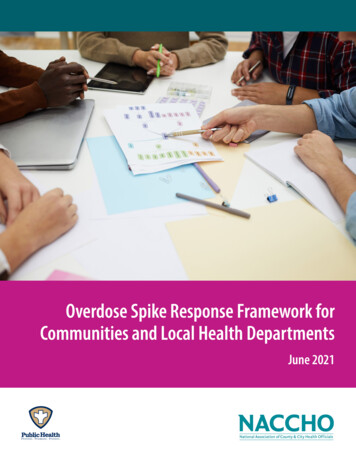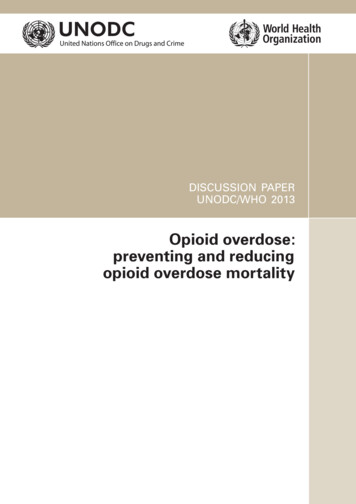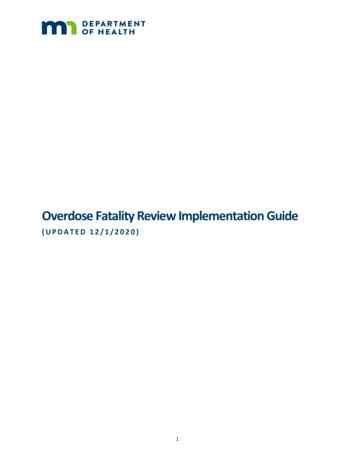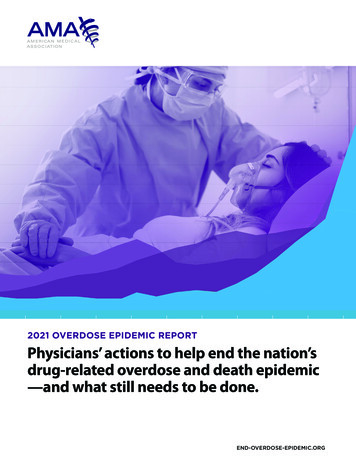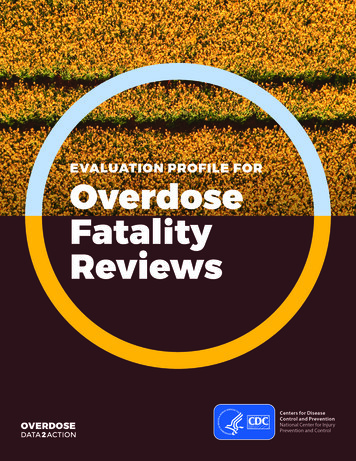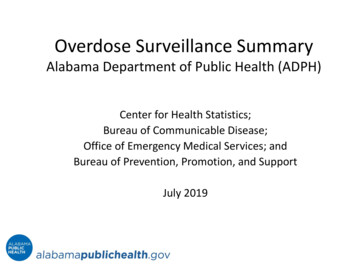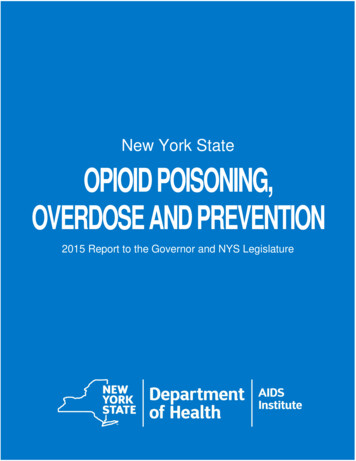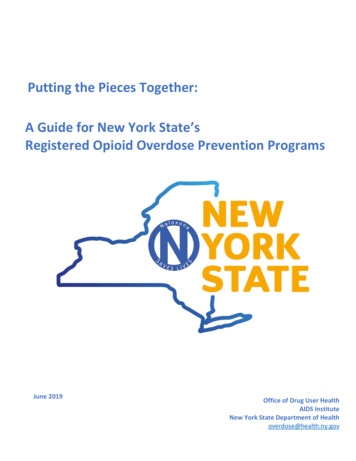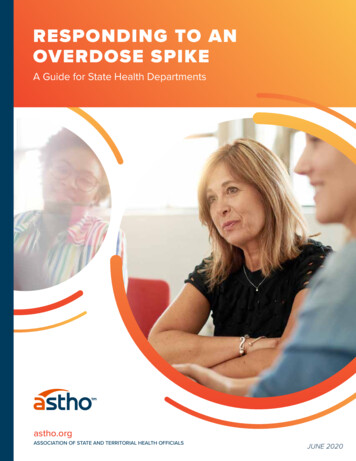
Transcription
RESPONDING TO ANOVERDOSE SPIKEA Guide for State Health Departmentsastho.orgASSOCIATION OF STATE AND TERRITORIAL HEALTH OFFICIALSResponding to an Overdose Spike: A GUIDE FOR STATE HEALTH DEPARTMENTSJUNE 2020
INTRODUCTIONThis guide aims to help state health officialsprepare for a rapid response to an opioidoverdose spike event. Key components ofan effective response include forming anoverdose spike response team (OSRT) andoverdose spike action plan (OSAP). Thisguide consists of potential action steps andfactors for success, for each phase of theplanning and response process. These tipsare followed by sample job action sheetsand other resources meant to support eachphase of the process.The information included in this guide isbased on a review of the literature andresources available on current practices,including protocols provided by Maryland,Washington state, and Georgia; HIDTA’sOverdose Detection Mapping Application(ODMAP) framework; and expert guidanceprovided by state representatives, federalpartners, and organizations that attendedASTHO’s Building State Opioid Preparednessmeeting in January 2019. For the localperspective, NACCHO provided feedbackon the guide and ASTHO staff attendedlocal tabletop exercises in Chattanooga andJohnson City, Tennessee to inform the guide.In May and July 2019, ASTHO conductedtabletop exercises with Utah and Georgiabased on the phases of this guide. Informationfrom the after-action reports from thoseexercises are incorporated in this guidebook.This guide is not meant to replace existingemergency protocols your state might have inplace. Rather, it is intended to serve as a modelto consult for augmenting or informing yourcurrent overdose spike response process.PRIMARY COMPONENTSPHASE 1: Pre-Incident PlanningPHASE 2: Immediate Phase (mobilization through first 12 hours)PHASE 3: Intermediate Phase (through 48 hours)PHASE 4: Longer-Term Response (beyond 48 hours)APPENDICESAPPENDIX A: Job Action Sheets for OSST PartnersAPPENDIX B: References and Background InformationAPPENDIX C: Calling for HelpAPPENDIX D: GlossaryAPPENDIX E: Decision TreeAPPENDIX F: Data for Opioid Surveillance1 This project and publication was supported by the cooperative agreement number, CDC-RFA-OT18-1802, funded by the Centers for Disease Control and Prevention. Its contents are solely theresponsibility of the authors and do not necessarily represent the official views of the Centers for Disease Control and Prevention or the Department of Health and Human Services. ASTHO wouldlike to thank all state and federal partners and national organizations that attended ASTHO’s Building State Opioid Preparedness meeting in January 2019 to discuss the content for this guide.Responding to an Overdose Spike: A GUIDE FOR STATE HEALTH DEPARTMENTS2
PHASE 1: PRE-INCIDENT PLANNINGPHASE 1:PRE-INCIDENT PLANNINGThe most effective response to an overdose spike will be achieved throughplanning for an event. Phase 1 consists of five main activities.PHASE 1 OVERVIEW:1. Identify surveillance team2. Define a “spike”3. Assemble an overdose spike response team4. Develop an overdose response plan(map state resources and gaps)5. Test the planOVERDOSESURVEILLANCE TEAM Coordinate a state-level surveillance team to: Identify existing data sources for surveillanceactivities at the local level and data the statecaptures directly; see Appendix F for examples ofdata to consider for the enhanced surveillance ofopioid-related morbidity and mortality Develop case definitions for overdoses Develop data sharing agreements, with informationabout what data are being shared, who can accessthe data, and how it can be used Analyze historical data to determine baselineaverages for fatal and nonfatal overdoses Identify a strategy for identifying spikes that occuracross or along local jurisdictional boundaries Provide ongoing surveillance of overdose datasources, such as syndromic surveillance data,PDMP data (if applicable), MAT providers, EMS/EDdata, coroner investigatory reports, etc.Responding to an Overdose Spike: A GUIDE FOR STATE HEALTH DEPARTMENTSPOTENTIAL OVERDOSESPIKE RESPONSE STRIKETEAM MEMBERS Attorney general Behavioral health lead Regional emergencycoordinator Office of drug controlpolicy director State social servicesofficials (including thosefrom mental health andchild protective services) Drug intelligence officer(from DEA) Chief medical officer Harm reduction lead State and local healthdepartment leads Pain clinics Chief epidemiologicalfield officer (CEFO) HIDTA Communicationsdirectors (from publicsafety, DOh, mayor’soffice, governor’s office) Medical director Public safety lead(s)– fire, EMS, lawenforcement Emergency departmentliaisons Community drugcoalitions People with livedexperiences Recovery communities Family and friends ofpeople who use opioids Neighboring local healthdepartments3
PHASE 1: PRE-INCIDENT PLANNINGDEFINE A SPIKEThis definition is critical to making a “go-nogo” decision for action. It will vary by state andby jurisdictions within states, and likely will bereadjusted over time.AFTER AN OPIOID INCIDENT,Utah Department of Health solicitedinput from stakeholders to updateUtah’s definition of an overdosespike cluster. They decided on fivedefinitions:1. An increase in the occurrence of fatal or non-fatalopioid overdoses above the current local rate for thetarget time period (weekly, quarterly, annually); or2. An increase in the occurrence of fatal or nonfatal opioid overdoses as identified by aberrationdetection and substantiated through dataverification; or3. The identification of populations experiencingrecurring fatal or non-fatal opioid overdose events; or4. The occurrence of an opioid overdose event incircumstances deemed by the LHD to be of crisistrigger significance [i.e. based on younger agegroups (less than 18 years of age), new opioidanalogs, location (school]; or5. The occurrence of two or more linked fatal or nonfatal opioid overdoses with a common exposuresource and geographic-time location. (e.g., opioidanalog as confirmed by laboratory testing, reportedbrand name, drug description, drug source, thirdparty notification, circumstantial evidence).Responding to an Overdose Spike: A GUIDE FOR STATE HEALTH DEPARTMENTSASSEMBLE AN OVERDOSESPIKE RESPONSE TEAM(OSRT)The size and composition of a response teamcan vary, and the deployment of the various teammembers will depend on the scope, location,and on-the-ground factors of the spike. The statehealth department should: Identify state-level OSRT co-leads. Co-leads willinitiate and coordinate the planning. At least onelead should be engaged with public health andsafety and have:1. v isibility over health and law enforcementefforts and2. ability to elevate key issues to ultimatedecision makers (directly report to cabinetlevel officials). Co-leads will then identify andrecruit OSRT members. Set up regular meetings with OSRT to: Conduct mission briefings with all partners/stakeholders so that everyone understandsand accepts roles and responsibilities Develop decision tree processes(see Appendix E) Develop job action sheets for each member(see Appendix A) Ensure the team understands state capacity, asassessed by a readiness assessment that: Identifies existing resources for the public(e.g., emergency hotlines) Surveys existing partnerships focused onoverdose prevention and response (e.g.,between public safety and public health) Assesses utility of treatment locators and ofthe frequency of updates Assesses ability to locate open beds4
PHASE 1: PRE-INCIDENT PLANNINGDEVELOP AN OVERDOSESPIKE ACTION PLAN (OSAP)A written plan or protocol can ensure that theteam understands how to operate during anevent. The plan should: Identify threshold for when the incidentcommand team and Emergency OperationsCenter (EOC) should be activated Identify threshold at which further assistancewill need to be sought out, such as (seeAppendix C): Requesting support from the CDC RapidResponse Team Requesting support through the EMAC(Emergency Management AssistanceCompact) Include goals and activities for immediate,intermediate, and longer-term responses(including an exit plan and hotwash process) Incorporate an after-hours response plan for thelocal public Include a communications plan for notifying keyagencies and partners: Craft one-pagers for different OSRT partners(see Appendix B for an example) Craft public service announcements fordifferent target audiences Engage with stakeholders, using language thatdoes not stigmatize substance use disorder Develop a “bad batch” community alert systemand template messageTIPS FOR RECRUITINGAND COLLABORATINGWITH OSRT MEMBERS: S haring data is often a good way to get people tothe table A mandate from the governor or executiveleadership can bring people to the table Speaking a common language can facilitate goodworking relationships, so developing a one-pagerof public health terms and definitions can facilitatecommunication Prepare template message(s) for alert system:to target audiences Consider holding focus groups to determine1. what language is most acceptable fordifferent geographical areas or populations;2. where to put messaging;3. what delivery mechanism(s) are mosteffective; and4. what info to include for different targetaudiences Establish a means of contact or communicationsystem with media groups and develop a planto distribute PSAs in the event of a spike For example, career epidemiology field officercan contact state health official, who can thennotify the media, harm reduction staff, etc.FACTORS FOR SUCCESS: RELATIONSHIP BUILDINGEncourage local departmentsof health (DOHs) to identify andconnect with other stakeholdersto be involved in or affected byresponse, for example: Emergency departments Medical examiner’s, coroner’soffices, and forensic laboratories Peer recovery specialists Community groups/coalitions/advocacy groups Naloxone distribution programs Drug treatment facilities People with lived experiencesand persons in the recoverycommunity Correctional facilities andprobation programs Schools and faith-based settings Social service agencies andHomeless shelters Syringe service programsResponding to an Overdose Spike: A GUIDE FOR STATE HEALTH DEPARTMENTS Media Families and friends of peoplewho use opioids Neighboring local healthdepartments5
PHASE 1: PRE-INCIDENT PLANNING Consider additional training and educationneeds, such as: Cross-training individuals from differentdisciplines, such as the ED staff;include state attorney’s office Training stakeholders in incidentcommand systems and language Conducting communications trainingfor key stakeholders at the state andlocal level Share your plan with local jurisdictionsand encourage them to develop their ownOSAP. Communicating with local partnersabout what will work locally can help themmake an informed go-no-go decision Consider a plan for supporting firstresponders and volunteer individualresponders (e.g., local medical reservecorps unit) against compassion fatigueSTAKEHOLDERS Prescribing professionals Law enforcementand first responders Local health districts Community membersSUGGESTEDTRAINING E nsure capacity to providetraining around tapering Naloxone administration Naloxone administration Naloxone administration Mental health crisistraining Public communicationstrategies Awareness of resources,including the hotline, safestations, and where tolook for information duringan incidence Applying for a MAT wavier Handling patients withco-morbid issues Good Samaritan laws Telehealth Compassion fatigue andavailable resources Standing orders Safety training, including: Investigation andevidence handling Searching subjects Special operations anddecontamination Personal protectiveequipmentTEST THE PLANExercises are critical for effective emergencypreparedness. Conduct tabletop exercises sothe response team can pilot test OSAP andmodify as needed. The exercise will help assessyour state’s level of preparedness and identifyareas of weakness to address through training.Responding to an Overdose Spike: A GUIDE FOR STATE HEALTH DEPARTMENTS6
PHASE 2: IMMEDIATE PHASE(MOBILIZATION THROUGH FIRST 12 HOURS)PHASE 2:IMMEDIATE PHASE(MOBILIZATION THROUGH FIRST 12 HOURS)PHASE 2 OVERVIEW:1. Assess the threatASSESS NEED FOR HELP2. Activate the team C an we function within normalday-to-day operations?3. Communicate the threat4. Eliminate the source Are we running out of resources?Which ones? How soon will we reach ourthreshold/exhaust our resources? What training considerations dowe need to make?ASSESS THE THREAT Keep up-to-date number ofoverdoses occurring, using realtime data from multiple sources Do we need to contact theCDC Emergency OperationsCenter (EOC) for rapid technicalassistance (TA)? Decide whether Identify source: work with drugintelligence officer, public safety, and law enforcementto gather preliminary information about the source ofthe drug causing overdose deaths Identify affected population(s):a. Perform active case finding; call local EMSand emergency department and ask aboutwho overdose victims are and where they areoverdosing;b. Establish a case definition and create a list ofconfirmed, probable, or possible cases andc. Conduct descriptive epidemiologyACTIVATE THE TEAM Alert and gather the response team partners Notify stakeholders in the affected jurisdictionsvirtual or in-person technicalassistance is necessary. Do we need to request anOpioid Rapid Response Teamfrom the CDC EmergencyResponse Operation Center? Do we need to declare a stateof emergency and engagethe Emergency ManagementAssistance Compact (EMAC)? Do we need to startimplementing an exit strategy? Make sure there is a clear line of command andchannels of communication Develop or implement plan to keep public healthoffice open on weekend and holiday and to havepublic health officials available to respond tocalls 24/7COMMUNICATE THE THREAT Get the word out to affected communities andstakeholders. Implement the communications plan(see Appendix B for communication templates)ELIMINATE THE SOURCE Coordinate with your drug lab, fusion center, bureauof investigation, HIDTA, and state poison control tohelp identify and eliminate the source Decide if the ICS needs to be implemented; if yes,designate an Incident Commander Delegate tasks to complete in first 12 hours or activatejob action plansResponding to an Overdose Spike: A GUIDE FOR STATE HEALTH DEPARTMENTS7
PHASE 3: IMMEDIATE PHASE(THROUGH 48 HOURS)PHASE 3:INTERMEDIATE PHASE(THROUGH 48 HOURS)Four main activities generally need to be implemented in the first 12 to 48 hours of an overdosespike. This time period will help determine whether the spike has subsided or is ongoing.However, it is often difficult to know if a spike has subsided within 48 hours. If it has definitelysubsided or moved to a different state, see Phase 4 – Step 1a.PHASE 3 OVERVIEW:1. Monitor the threat/enhanced surveillance2. Communicate the threat3. Monitor, assess, and engage key resources4. Assess need for helpMONITOR THE THREAT/ENHANCED SURVEILLANCE Look at data regularly Re-assess that you know what drug you aredealing with Consider data from regional EMS, localemergency departments, enhanced surveillance(active and syndromic); active surveillance isneeded even in areas with Overdose DetectionMapping Application (ODMAP) (see Appendix F) Assess input from multiple data/intel sources toconfirm a downward trend in overdoses Assess data from HIDTA to determine whetherthe spike is moving to another area within thestate or to neighboring state. May need toconduct regional calls Assess DEA and law enforcement data todetermine if this source is being eliminatedCOMMUNICATETHE THREAT Information campaign is critical in first 24 hours Get messages out to key stakeholders and highrisk individuals, such as pain clinic patients. Painclinics may want to notify their own patients andincrease services as needed Reassess communication messages, deliverymechanisms, and target locations and tweak ifnecessary – are they still accurate/appropriate?(see Appendix B for resources aboutcommunication) Issue a public service announcement (ifnecessary) Form a joint information center (JIC), whichinvolves regular and frequent meetings amongall the public information officers (PIOs) todiscuss the upcoming report and walk throughthe talking points for consistent messaging Notify up the chain, if necessaryResponding to an Overdose Spike: A GUIDE FOR STATE HEALTH DEPARTMENTS8
PHASE 3: IMMEDIATE PHASE(THROUGH 48 HOURS)MONITOR, ASSESS, AND ENGAGEKEY RESOURCES Ensure availability and distribution of naloxone tokey areas Work with stakeholders on the rapid distributionof naloxone to affected communities Team going to sites should include a peer fromthe affected population Check pharmacists’ knowledge of standing orders Check availability of protective gear for first responders Check availability of hospital beds for treatment andrehabilitation Check capacity of addiction treatment facilities andpeer navigator programs to meet with clients followinga nonfatal overdose Check capacity of morgues to house fatal overdosevictims May need to conduct DEA drug recognitiontraining for public health officials or forlaw enforcement (e.g., what does blacktar look like?) Activate a 24-hour warmline ifthreat looks like it will continuepast 24 hoursResponding to an Overdose Spike: A GUIDE FOR STATE HEALTH DEPARTMENTS9
PHASE 4: LONGER TERM RESPONSE(BEYOND 48 HOURS)PHASE 4:LONGER TERM RESPONSE(BEYOND 48 HOURS)During this phase, the overdose spike may have or be in the process of subsiding.The information below should help inform your response for both scenarios.There are three main activities during this stage, most of which overlap with Phase 3.PHASE 4 OVERVIEW:1. Monitor the threat2. Conduct follow-up communication3. Monitor continuity of care and resourcesMONITOR THE THREATIf the threat of a continued spike in overdoses hassubsided: Conduct an evaluation/hotwash of the response Create an after-action review (AAR) to documentthe best practices, gaps, and lessons learned toimprove the emergency response process Consider additional partners for the OSRT forfuture responses Incorporate the AAR into your state’s responseplan or draft a response plan if the state does nothave an official plan in place Consider ongoing care coordination for patientswho experienced a non-fatal overdoseIf the threat is still present, return to Phase 3 andconsider contacting CDC’s for assistance (seeAppendix C)CONDUCT FOLLOW UPCOMMUNICATION Re-assess communications activities (e.g., theneed to continue the hotline) and restructureplan if needed Conduct additional follow-up with DOH asneeded Conduct regional calls with neighboring states ifnecessary Consider increasing awareness for testing theaffected population for blood borne pathogens(e.g., HIV, hepatitis)MONITOR CONTINUITY OFCARE AND RESOURCES Monitor, assess, and utilize key resources,including monitoring of personnel and firstresponders for fatigue Ensure availability and distribution of naloxone tokey areas Check availability of hospital beds for treatmentand rehabilitation Check capacity of addiction treatment facilities Check capacity of morgues to house fataloverdose victimsResponding to an Overdose Spike: A GUIDE FOR STATE HEALTH DEPARTMENTS10
Appendix A:APPENDIX A:JOB-ACTIONSHEETSFORJOB-ACTIONSHEETSFOR OSST PARTNERSOSST PARTNERSastho.orgASSOCIATION OF STATE AND TERRITORIAL HEALTH OFFICIALS
RESPONSE TEAM MEMBER JOB-ACTION SHEETBEHAVIORAL HEALTH SPECIALIST1. Member Title: Behavioral Health Specialist2. Incident Type: OD Cluster or Pain Center Closure3. Member Roles—Immediate (Mobilization through first 24 hours) Attend Operational Briefing Receive tactical assignment Monitor use of existing resources and report needs Maintain situational awareness Document actions in Unit Log Assist in coordination of on-scene behavioral health responders, if requested by local incident managementpersonnel Consult with staff, patients, clients, and family members on appropriate behavioral health services needed Assist patients, clients, and family members in location of and connection to available behavioral healthservices Observe Strike Team members for signs of stress or emotional difficulty; refer for support or substitution ifneeded Support Team Leader’s efforts to provide key information to jurisdictional incident management system Brief relief member at end of shift4. Member Roles— Intermediate (Through Week One) All items above Assist with position-specific team member replacements as needed Begin planning early for team demobilization Begin planning for incident after action review Begin demobilization procedures as directed Begin after action process as directed5. Member Roles—Extended (Beyond Week One) All items above Begin planning for transition to longer term “in house” management of the incident6. Team Member Training Needs Appropriate FEMA National Incident Management Courses (ICS 100,200,700) Specific Behavioral Health Training, including Professional/Clinical Services Training Cultural Competency Training (specific to the incident location)Responding to an Overdose Spike: APPENDIX A12
RESPONSE TEAM MEMBER JOB-ACTION SHEETCLINICAL CARE SPECIALIST1. Member Title: Clinical Care Specialist2. Incident Type: OD Cluster or Pain Center Closure3. Member Roles—Immediate (Mobilization through first 24 hours) Attend Operational Briefing Receive tactical assignment Monitor use of existing resources and report needs Maintain situational awareness Document actions in Unit Log Assess current clinical/health care resources for needs Provide consultation to clinic managers (Pain Center Closure), hospitals, health departments (OD Cluster) asneeded Assure that appropriate client or patient referral practices are engaged Support Epidemiology Specialist team member in acquisition of needed medical records and other incidentspecific information needed for field investigation or surveillance processes Support Team Leader’s efforts to provide key information to jurisdictional incident management system Brief relief member at end of shift4. Member Roles—Intermediate (Through Week One) All items above Assist with position-specific team member replacements as needed Begin planning early for team demobilization Begin planning for incident after action review Begin demobilization procedures as directed Begin after action process as directed5. Member Roles—Extended (Beyond Week One) All items above Begin planning for transition to longer term “in house” management of the incident6. Team Member Training Needs Appropriate FEMA National Incident Management Courses (ICS 100,200,700) Health Care Management Training Clinical Care Training (RN, MD, etc. not required, but recommended) Cultural Competency Training (specific to the incident location)Responding to an Overdose Spike: APPENDIX A13
RESPONSE TEAM MEMBER JOB-ACTION SHEETEMERGENCY MEDICAL SERVICES(EMS) SPECIALIST1. Member Title: EMS Specialist2. Incident Type: OD Cluster3. Member Roles—Immediate (Mobilization through first 24 hours) Attend Operational Briefing Receive tactical assignment Monitor use of existing resources and report needs Maintain situational awareness Document actions in Unit Log Assist local incident management in assessing need for additional (external) jurisdiction EMS assets Assist responding EMS agencies with replacement of depleted Naloxone and other prehospital caresupplies, if needed Assist responding EMS agencies with pertinent information for reporting, after action review, etc. Support Team Leader’s efforts to provide key information to jurisdictional incident management system Brief relief member at end of shift4. Member Roles—Intermediate (Through Week One) All items above Assist with position-specific team member replacements as needed Begin planning early for team demobilization Begin planning for incident after action review Begin demobilization procedures as directed Begin after action process as directed5. Member Roles—Extended (Beyond Week One) All items above Begin planning for transition to longer term “in house” management of the incident6. Team Member Training Needs Appropriate FEMA National Incident Management Courses (ICS 100,200,700) EMS Technical Training (EMT/Paramedic) optional but recommended Cultural Competency Training (specific to the incident location)Responding to an Overdose Spike: APPENDIX A14
RESPONSE TEAM MEMBER JOB-ACTION SHEETEPIDEMIOLOGY SPECIALIST1. Member Title: Epidemiology Specialist2. Incident Type: OD Cluster or Pain Center Closure3. Member Roles—Immediate (Mobilization through first 24 hours) Attend Operational Briefing Receive tactical assignment Monitor use of existing resources and report needs Maintain situational awareness Document actions in Unit Log Initiate field investigation and surveillance processes, including case definition, incident rate, populationhealth assessment, clinical picture, etc. Assist Clinical Care Specialist team member with consultation and key epidemiology information to supportclient/patient care Develop appropriate public health interventions Provide consultation services to health care services and public health leadership Document and report findings Support Team Leader’s efforts to provide key information to jurisdictional incident management system Brief relief member at end of shift4. Member Roles—Intermediate (Through Week One) All items above Assist with position-specific team member replacements as needed Begin planning early for team demobilization Begin planning for incident after action review Begin demobilization procedures as directed Begin after action process as directed5. Member Roles—Extended (Beyond Week One) All items above Begin planning for transition to longer term “in house” management of the incident6. Team Member Training Needs Appropriate FEMA National Incident Management Courses (ICS 100,200,700) Epidemiology and Surveillance-Specific Training Cultural Competency Training (specific to the incident location)Responding to an Overdose Spike: APPENDIX A15
RESPONSE TEAM MEMBER JOB-ACTION SHEETFATALITY MANAGEMENT SPECIALIST1. Member Title: Fatality Management Specialist2. Incident Type: OD Cluster3. Member Roles—Immediate (Mobilization through first 24 hours) Attend Operational Briefing Receive tactical assignment Monitor use of existing resources and report needs Maintain situational awareness Document actions in Unit Log Assist local jurisdictions in identification, appropriate movement, and storage of remains Assist with additional storage solutions (e.g., state medical examiner facility) for fatality surge Develop report with fatality numbers, information, location, etc. as needed and allowed by law Support Team Leader’s efforts to provide key information to jurisdictional incident management system Brief relief member at end of shift4. Member Roles—Intermediate (Through Week One) All items above Assist with position-specific team member replacements as needed Begin planning early for team demobilization Begin planning for incident after action review Begin demobilization procedures as directed Begin after action process as directed5. Member Roles—Extended (Beyond Week One) All items above Begin planning for transition to longer term “in house” management of the incident6. Team Member Training Needs Appropriate FEMA National Incident Management Courses (ICS 100,200,700) Coroner, Medical Examiner, Pathology Training not required, but recommended Cultural Competency Training (specific to the incident location)Responding to an Overdose Spike: APPENDIX A16
RESPONSE TEAM MEMBER JOB-ACTION SHEETHUMAN SERVICES SPECIALIST1. Member Title: Human Services Specialist2. Incident Type: OD Cluster or Pain Center Closure3. Member Roles—Immediate (Mobilization through first 24 hours) Attend Operational Briefing Receive tactical assignment Monitor use of existing resources and report needs Maintain situational awareness Document actions in Unit Log Assist clients, patients, and families with Medicare, Medicaid, and other related state or community socialservices Engage Children’s or Adult Protective Services as needed (OD cluster) Assist clients in transitioning to other clinical centers (pain center closure) Support Team Leader’s efforts to provide key information to jurisdictional incident management system Brief relief member at end of shift4. Member Roles—Intermediate (Through Week One) All items above Assist with position-specific team member replacements as needed Begin planning early for team demobilization Begin planning for incident after action review Begin demobilization procedures as directed Begin after action process as directed5. Member Roles—Extended (Beyond Week One) All items above Begin planning for transition to longer term “in house” management of the incident6. Team Member Training Needs Appropriate FEMA National Incident Management Courses (ICS 100,200,700) Specific, job-related training for human services type employment Cultural Competency Training (specific to the incident location)Responding to an Overdose Spike: APPENDIX A17
RESPONSE TEAM MEMBER JOB-ACTION SHEETINCIDENT MANAGEMENT SPECIALIST1. Member Title: Incident Management Specialist2. Incident Type: OD Cluster or Pain Center Closure3. Member Roles—Immediate (Mobilization through first 24 hours) Attend Operational Briefing Receive tactical assignment Monitor use of existing resources and report needs Maintain si
The most effective response to an overdose spike will be achieved through planning for an event. Phase 1 consists of five main activities. PHASE 1 OVERVIEW: 1. Identify surveillance team 2. Define a "spike" 3. Assemble an overdose spike response team 4. Develop an overdose response plan (map state resources and gaps) 5. Test the plan .
